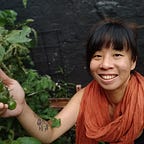“Sorry guys. I can’t this weekend. Mum’s throwing a popiah party”
“Oh man, really?? Urgh ok, fine. Your mum’s popiah parties are pretty epic”
“Eh. Can tapao some for me anot?” *
—
Every so often, when I was growing up, my mother would hold a ‘popiah party’. They were usually held in the afternoon at tea time, and were highly civilised affairs.
The fancy platters with delicate, hand-painted designs were brought out. The white table-cloths were freshly laundered and pressed. Orders for specialist ingredients were made the week before as everything was hand-made, and the few artisans that remained sold out fast.
I moved to Australia from Singapore 16 years ago and have been on a personal culinary journey since. Learning to reproduce the Peranakan food that I grew up with — the smells and tastes of home. Popiah, in the form that I grew up with, is the one dish that eludes me because even back home, we relied on outside production of a handful of key ingredients.
To call it a ‘fresh spring roll’ does not do justice to the riot of textures and flavours encapsulated in the delicate handmade flour skins.
The bulk of the filling is made with finely sliced bangkuang (yam bean or jicama), carrot and green beans slowly braised in a pork and prawn stock flavoured with taucheong (fermented soy beans). Some recipes will tell you to grate the root vegetables, but this reduces them to mush upon braising, and you lose the beautiful bite of the bangkuang — the illegitimate love-child of a turnip and a nashi pear.
Then, crisp lettuce, fresh steamed prawns, thinly-sliced chinese sausage, slivers of an egg omelette, fried shallots, crispy garlic, coriander, crushed roasted peanuts, toasted dried shrimp, a pounded chilli paste and a drizzle of bee cheo — a sticky sweet rice flour sauce made from gula melaka (coconut palm sugar), soy, and toasted rice flour. All rolled into a tight, bulging burrito-like shape without breaking the paper-thin skin.
It is then sliced into discs like sushi, and eaten with chopsticks, because remember, it is a highly civilised affair akin to high tea.
We are not animals Debbie. Use your chopsticks properly, don’t squash the popiah.
A good popiah skin can be likened to peking duck crepes, but infinitely thinner. Translucent almost. It is a simple mix of starch, water and salt. The gluten is worked to elasticity and is rested and left to ferment overnight. The next day, it has the consistency of a wet putty.
It takes an incredible amount of skill to handle this dough. As a child, I used to watch the auntie at the shop, mesmerised as she constantly twirled the putty around her hand and wrist. She would brush the large, round flat griddle ever so briefly with the dough, leaving a thin film of white that cooked in seconds. With her other hand, she would peel the skin off the hot-plate with her fingers and place it expertly onto the growing pile next to her, and the process would start again.
These skins have to be consumed on the day that they are made. Leave them out for too long, and they will dry out. Leave them too long under a damp towel, and they will eventually start to stick together.
Then, there is the sweet sauce. There is only one brand that I know of that makes it commercially. I have hunted high and low for it and have never been able to find it in the Asian groceries here. Back home, we used to buy it from the same auntie that makes the popiah skins. Making it from scratch is a long, time-consuming process that involves the slow toasting of rice flour to a pink-ish brown hue, sifting it multiple times and mixing it with a caramel made from gula melaka and light soy.
Aiyoh… girl, don’t put so much bee cheo. Afterwards everything sweet, cannot taste anything else.
Popiah parties also always include pie tie. These are small, thin, canape-sized deep fried pastry cases that are usually filled with the braised jicama filling, topped with a sliced prawn, a sprig of coriander, a dollop of chilli paste and a drizzle of the sweet sauce. Kids love these as they are crunchy and snacky and require neither plates not cutlery. I could snack on these all afternoon if I was allowed to.
Debbie, stop eating the pie tee. Leave some for the guests.
The pie tie shells are made using a ridged metal (often copper or brass) mould that looks almost like a branding iron at the end of long metal handle bent at 90 degrees. The mould is dipped into hot oil and then into a fairly liquid batter of water, egg and flour and then dunked back into the oil. A thin shell forms and detaches itself in the bubbling oil once it has cooked and hardened. These are available commercially in Singapore, but because they are so fragile and brittle, they are not often exported.
On my last trip back home, I bought a bottle of the sweet sauce from the same auntie that we’ve been going to for years. It’s in my pantry, un-opened as yet. I also bought the brass pie tie moulds. I’ve been practicing. I think I’m getting good. I’ve made the filling successfully many times.
The only thing that eludes me now are the popiah skins, but soon, I’ll be able to hold my own popiah parties when my family flies over to visit.
In a way, it feels like I’m finally coming home.
Mum, they have bangkuang here. I found it in Footscray market. I don’t have to use turnip any more.
______________
* ”Hey. Can you put some in a doggy bag for me?”
